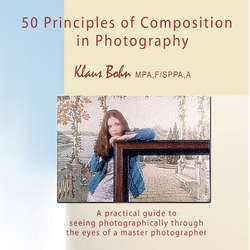Читать книгу 50 Principles of Composition in Photography: A Practical Guide to Seeing Photographically Through the Eyes of A Master Photographer - Klaus Bohn - Страница 8
На сайте Литреса книга снята с продажи.
ОглавлениеPhotography: Unlike the Other “Fine” Arts
Painting, sculpture and many other fine arts are performed by dexterity coupled with talent, which is the ability to see and perceive the harmony of parts not necessarily in front of the artist.
Photography cannot be performed without the subject being in front of the lens. Consequently, it is a reproduction type of art. Not belittling the ability to manipulate the machinery and, of course, the talent to see and put together the photograph using composition in an appealing manner. To be an elite photographer, it goes without saying that one must know their equipment completely, performing as if it were second nature. Lighting and recording the magic in such a way that their desired statement is made important. It does necessitate the knowledge of film performance and paper latitude finishes in order to enhance the end product.
Unfortunately, many ‘would-be’ professionals have not advanced beyond the basics of photography using their cameras simply as a mechanical paintbrush or painting by numbers. For example, they place the camera here, use such and such a focal length lens for portraits and nail the light in such a position that it is rarely moved. They perform all portraits with the same type of lighting regardless of the mood desired or age of subject. Sending out their film and never giving it a second thought for the printing aspect, ie. deep or light printing, they leave it up to lab personnel who have no idea as to what mood or end result the photographer had in mind.
The talented photographer has mastered their equipment. In most cases they know exactly how they would like the subject to be presented and finished even before the button is pushed on their camera.
Like the painter, the talented photographer has the ability to pre-visualize exactly what they want, and once the idea is born in their mind, from there on it is anticlimactic. They just need the props, to assemble their equipment accordingly, and then evoke the desired expression that they have conceptualized.
Many unimaginative photographers try to make their photographs by thinking through the camera, not giving their subject any forethought. This will only produce snapshots. The photographer performs these same pictures day after day, only changing the faces and rarely ever changes their composition. If this does occur, it is only because they are copying what they have seen produced by someone else.
Only those photographers who work by talent will perpetually compose photographs that have originality and life. Only then may they be considered a work of art. This, of course, is not inherent in everyone.
May those amongst us with a driving talent persevere their shortcomings and stand true to their calling.
